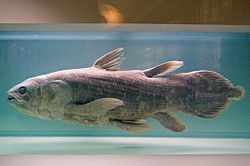Coelacanth

| We're all Homo here Evolution |
| Relevant Hominids |
| A Gradual Science |
| Plain Monkey Business |
The coelacanths (derived from Coelacanthiformes, and named after the Carboniferous genus Coelacanthus) are the most archaic extant lineage of the Sarcopterygii, the so-called lobe-finned fishes from within which all tetrapods evolved. Never a highly diverse order of fish, today the coelacanths are represented by the single extant genus Latimeria, with just two species living in deep water off the coasts of southern and eastern Africa, Madagascar, and Sulawesi, Indonesia.
Coelacanths shot into the public eye after Marjorie Courtenay-Latimer![]() (for whom the genus Latimeria is named) discovered the modern species Latimeria chalumnae in South Africa in 1938, as the entire order of coelacanths had previously been thought to have gone extinct 66 million years ago in the K-Pg extinction event. Coelacanths are completely inedible (both for humans and for most other animals) due to a variety of noxious chemicals in their flesh. The few people stupid enough to try eating them invariably come down with vicious vomiting and diarrhea. This probably goes a long way towards explaining their longevity as a species.
(for whom the genus Latimeria is named) discovered the modern species Latimeria chalumnae in South Africa in 1938, as the entire order of coelacanths had previously been thought to have gone extinct 66 million years ago in the K-Pg extinction event. Coelacanths are completely inedible (both for humans and for most other animals) due to a variety of noxious chemicals in their flesh. The few people stupid enough to try eating them invariably come down with vicious vomiting and diarrhea. This probably goes a long way towards explaining their longevity as a species.
Evolutionary history[edit]
Coelacanths first appear in the mid-Devonian and diverged into many different types in the late Paleozoic, reaching their peak in the Triassic.[2] Coelacanths are fish and thus are related to the ancestors of tetrapods (amphibians, synapsids, and sauropsids), though they evolved differently from the rhipidistian fishes (including lungfish). It was once thought that coelacanths were the closest evolutionary relatives to tetrapods, but DNA evidence has shown lungfish to be more closely related.[3][4]
Living fossil[edit]
The coelacanth is an iconic "living fossil," having been known only from fossils before the first living specimen was discovered. As a group, the coelacanths were very successful from the Devonian until the Cretaceous, with several genera and species described, but the modern genus Latimeria is not known from the fossil record. The earliest known coelacanths are in fact quite different from Latimeria. The last known fossil coelacanths are the late Cretaceous genus Macropoma, which is very similar to Latimeria. No fossils are known from the Cretaceous until the present. The reason for this gap in the fossil record is not known, but suggests that, since the Cretaceous period, coelacanths have either been relatively rare or have inhabited environments not conducive to fossilization.
Only two living species are known—the West Indian Ocean coelacanth (L. chalumnae), and the Indonesian coelacanth (L. menadoensis). The two are, however, easily distinguished by their colouring; a steely-blue colouration is typical of the West Indian Ocean coelacanth, where the Indonesian coelacanth has a more brownish tint.
Live Latimeria menadoensis specimen with a diver in Indonesia.
Further reading[edit]
- Carroll, R. 1988. Vertebrate Paleontology and Evolution. W. H. Freeman & Company, New York.
- Thomson, K. S. 1967. Mechanisms of intracranial kinetics in fossil rhipidistian fishes (Crossopterygii) and their relatives. Zoological Journal of the Linnean Society 46: 223-253.
References[edit]
- ↑ Tom Weller, Science Made Stupid
- ↑ Schaeffer, B. 1952. The Triassic coelacanth fish Diplurus, with observations on the evolution of the Coelacanthini. Bulletins of the American Museum of Natural History 99: 25-78.
- ↑ The African coelacanth genome provides insights into tetrapod evolution by Amemiya, Chris T. et al. (18 April 2013)Nature 496 (7445): 311–6.
- ↑ DNA Sequencing Reveals that Coelacanths Weren’t the Missing Link Between Sea and Land by Joseph Stromberg (April 17, 2013) Smithsonian.




